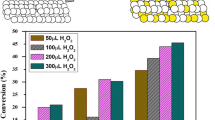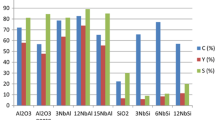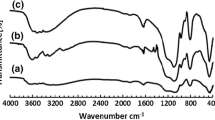Abstract
This work investigated the effect of reaction pressure (1 bar and 30 bar of total pressure) in the hydrodeoxygenation (HDO) of m-cresol over both catalysts: Pd/SiO2 and Pd/Nb2O5. The results revealed that the catalytic properties of the solids strongly depended on the type of support (silica vs niobia) and reaction conditions (atmospheric vs high pressure). Irrespective the catalyst, an increase of the pressure significantly rose the total reaction rate. The product distribution over Pd/SiO2 catalyst was practically no affected by the reaction pressure, 3-methylcyclohexanone being the main product at atmospheric and high pressure. On the contrary, Pd/Nb2O5 showed significantly higher selectivity toward deoxygenated products, toluene or 3-methylcyclohexane depending the pressure used, the former favored under atmospheric pressure and the latter under 30 bar. This was mainly attributed to the ability of niobia in activating the C–O bond due to its superior oxophilicity. Reaction pressure also affect the stability of catalyst. Pd/Nb2O5 deactivated during 6 h of TOS under atmospheric pressure (loss of 40% in m-cresol conversion) while it remained quite stable at high pressure.
Graphical Abstract
The effect of pressure in the hydrodeoxygenation of m-cresol was investigated over Pd/SiO2 and Pd/Nb2O5 catalysts. Their catalytic performance strongly depended on the type of support and reaction conditions. An increase of the pressure significantly rose the total reaction rates, favored the selectivity into deoxygenated products and stabilized their catalytic performances.










Similar content being viewed by others
References
Zhang J, Sun J, Wang Y (2020) Recent advances in the selective catalytic hydrodeoxygenation of lignin-derived oxygenates to arenes. Green Chem 22:1072–1098. https://doi.org/10.1039/C9GC02762A
Kumar R, Strezov V (2021) Thermochemical production of bio-oil: a review of downstream processing technologies for bio-oil upgrading, production of hydrogen and high value-added products. Renew Sustain Energy Rev 135:110152. https://doi.org/10.1016/j.rser.2020.110152
Stummann MZ, Høj M, Gabrielsen J et al (2021) A perspective on catalytic hydropyrolysis of biomass. Renew Sustain Energy Rev 143:110960. https://doi.org/10.1016/j.rser.2021.110960
Jin W, Pastor-Pérez L, Shen D et al (2019) Catalytic upgrading of biomass model compounds: novel approaches and lessons learnt from traditional hydrodeoxygenation: a review. Chem Cat Chem 11:924–960. https://doi.org/10.1002/cctc.201801722
Kim S, Kwon EE, Kim YT et al (2019) Recent advances in hydrodeoxygenation of biomass-derived oxygenates over heterogeneous catalysts. Green Chem 21:3715–3743. https://doi.org/10.1039/C9GC01210A
Li C, Zhao X, Wang A et al (2015) Catalytic transformation of lignin for the production of chemicals and fuels. Chem Rev 115:11559–11624. https://doi.org/10.1021/acs.chemrev.5b00155
Shafaghat H, Rezaei PS, Daud WMAW (2015) Effective parameters on selective catalytic hydrodeoxygenation of phenolic compounds of pyrolysis bio-oil to high-value hydrocarbons. RSC Adv 5:103999–104042. https://doi.org/10.1039/C5RA22137D
Kay Lup AN, Abnisa F, Daud WMAW, Aroua MK (2017) A review on reaction mechanisms of metal-catalyzed deoxygenation process in bio-oil model compounds. Appl Catal A 541:87–106. https://doi.org/10.1016/j.apcata.2017.05.002
Mortensen PM, Grunwaldt J-D, Jensen PA, Jensen AD (2016) Influence on nickel particle size on the hydrodeoxygenation of phenol over Ni/SiO2. Cataly Today. https://doi.org/10.1016/j.cattod.2015.08.022
Gonçalves VOO, de Souza PM, Cabioc’h T, et al (2019) Effect of P/Ni ratio on the performance of nickel phosphide phases supported on zirconia for the hydrodeoxygenation of m-cresol. Catal Commun 119:33–38. https://doi.org/10.1016/j.catcom.2018.09.015
Gonçalves VOO, Talon WHSM, Kartnaller V et al (2021) Hydrodeoxygenation of m-cresol as a depolymerized lignin probe molecule: synergistic effect of NiCo supported alloys. Catal Today 377:135–144. https://doi.org/10.1016/j.cattod.2020.10.042
Zhao C, Kasakov S, He J, Lercher JA (2012) Comparison of kinetics, activity and stability of Ni/HZSM-5 and Ni/Al2O3-HZSM-5 for phenol hydrodeoxygenation. J Catal 296:12–23. https://doi.org/10.1016/j.jcat.2012.08.017
Shetty M, Murugappan K, Prasomsri T et al (2015) Reactivity and stability investigation of supported molybdenum oxide catalysts for the hydrodeoxygenation (HDO) of m-cresol. J Catal 331:86–97. https://doi.org/10.1016/j.jcat.2015.07.034
Gonçalves VOO, Ciotonea C, Arrii-Clacens S et al (2017) Effect of the support on the hydrodeoxygenation of m -cresol over molybdenum oxide based catalysts. Appl Catal B 214:57–66. https://doi.org/10.1016/j.apcatb.2017.05.003
de Souza PM, Nie L, Borges LEP et al (2014) Role of oxophilic supports in the selective hydrodeoxygenation of m-cresol on pd catalysts. Catal Lett 144:2005–2011. https://doi.org/10.1007/s10562-014-1337-y
de Souza PM, Rabelo-Neto RC, Borges LEP et al (2015) Effect of zirconia morphology on hydrodeoxygenation of phenol over Pd/ZrO2. ACS Catal 5:7385–7398. https://doi.org/10.1021/acscatal.5b01501
de Souza PM, Rabelo-Neto RC, Borges LEP et al (2015) Role of keto intermediates in the hydrodeoxygenation of phenol over pd on oxophilic supports. ACS Catal 5:1318–1329. https://doi.org/10.1021/cs501853t
Furimsky E (2000) Catalytic hydrodeoxygenation. Appl Catal A 199:147–190. https://doi.org/10.1016/S0926-860X(99)00555-4
Gonçalves VOO, de Souza PM, da Silva VT et al (2017) Kinetics of the hydrodeoxygenation of cresol isomers over Ni2P/SiO2: proposals of nature of deoxygenation active sites based on an experimental study. Appl Catal B 205:357–367. https://doi.org/10.1016/j.apcatb.2016.12.051
Teles CA, Ciotonea C, Nicolas G et al (2022) Hydrodeoxygenation of m-cresol over Pd/Al-SBA-15 catalysts: effect of al content on the deoxygenation reaction pathways. Appl Catal A 641:118686. https://doi.org/10.1016/j.apcata.2022.118686
Nie L, Resasco DE (2014) Kinetics and mechanism of m-cresol hydrodeoxygenation on a Pt/SiO2 catalyst. J Catal 317:22–29. https://doi.org/10.1016/j.jcat.2014.05.024
Nie L, de Souza PM, Noronha FB et al (2014) Selective conversion of m-cresol to toluene over bimetallic Ni–Fe catalysts. J Mol Catal A Chem 388–389:47–55. https://doi.org/10.1016/j.molcata.2013.09.029
Teles CA, Rabelo-Neto RC, Jacobs G et al (2017) Hydrodeoxygenation of phenol over zirconia-supported catalysts: the effect of metal type on reaction mechanism and catalyst deactivation. Chem Cat Chem 9:2850–2863. https://doi.org/10.1002/cctc.201700047
Barrios AM, Teles CA, de Souza PM et al (2018) Hydrodeoxygenation of phenol over niobia supported pd catalyst. Catal Today 302:115–124. https://doi.org/10.1016/j.cattod.2017.03.034
Xiong H, Pham HN, Datye AK (2013) A facile approach for the synthesis of niobia/carbon composites having improved hydrothermal stability for aqueous-phase reactions. J Catal 302:93–100. https://doi.org/10.1016/j.jcat.2013.03.007
Teles CA, Rabelo-Neto RC, de Lima JR et al (2016) The effect of metal type on hydrodeoxygenation of phenol over silica supported catalysts. Catal Lett 146:1848–1857. https://doi.org/10.1007/s10562-016-1815-5
Teles CA, Rabelo-Neto RC, Duong N et al (2020) Role of the metal-support interface in the hydrodeoxygenation reaction of phenol. Appl Catal B 277:119238. https://doi.org/10.1016/j.apcatb.2020.119238
Galano A, Rodriguez-Gattorno G, Torres-García E (2008) A combined theoretical–experimental study on the acidity of WOx-ZrO2 systems. Phys Chem Chem Phys 10:4181–4188. https://doi.org/10.1039/B802934B
Teles CA, de Souza PM, Rabelo-Neto RC et al (2018) Catalytic upgrading of biomass pyrolysis vapors and model compounds using niobia supported Pd catalyst. Appl Catal B 238:38–50. https://doi.org/10.1016/j.apcatb.2018.06.073
Zhao Y, Zhou X, Ye L, Chi Edman Tsang S (2012) Nanostructured Nb2O5 catalysts. Nano Rev 3:17631. https://doi.org/10.3402/nano.v3i0.17631
Ziolek M (2003) Niobium-containing catalysts the state of the art. Catal Today 78:47–64. https://doi.org/10.1016/S0920-5861(02)00340-1
Ushikubo T (2000) Recent topics of research and development of catalysis by niobium and tantalum oxides. Catal Today 57:331–338. https://doi.org/10.1016/S0920-5861(99)00344-2
Lu M, Du H, Wei B et al (2017) Catalytic hydrodeoxygenation of guaiacol over palladium catalyst on different titania supports. Energy Fuels 31:10858–10865. https://doi.org/10.1021/acs.energyfuels.7b01498
de Souza PM, Rabelo-Neto RC, Borges LEP et al (2017) Hydrodeoxygenation of phenol over pd catalysts. Effect of support on reaction mechanism and catalyst deactivation. ACS Catal 7:2058–2073. https://doi.org/10.1021/acscatal.6b02022
Teles CA, de Souza PM, Braga AH et al (2019) The role of defect sites and oxophilicity of the support on the phenol hydrodeoxygenation reaction. Appl Catal B 249:292–305. https://doi.org/10.1016/j.apcatb.2019.02.077
Tan Q, Wang G, Nie L et al (2015) Different product distributions and mechanistic aspects of the hydrodeoxygenation of m-cresol over platinum and ruthenium catalysts. ACS Catal. https://doi.org/10.1021/acscatal.5b00765
Griffin MB, Ferguson GA, Ruddy DA et al (2016) Role of the support and reaction conditions on the vapor-phase deoxygenation of m-cresol over Pt/C and Pt/TiO2 catalysts. ACS Catal. https://doi.org/10.1021/acscatal.5b02868
Robinson A, Ferguson GA, Gallagher JR et al (2016) Enhanced hydrodeoxygenation of m -Cresol over bimetallic Pt–Mo catalysts through an oxophilic metal-induced tautomerization pathway. ACS Catal 6:4356–4368. https://doi.org/10.1021/acscatal.6b01131
Teles CA, de Souza PM, Rabelo-Neto RC et al (2021) Hydrodeoxygenation of lignin-derived compound mixtures on pd-supported on various oxides. ACS Sustain Chem Eng 9:12870–12884. https://doi.org/10.1021/acssuschemeng.1c03720
Kepp KP (2016) A quantitative scale of oxophilicity and thiophilicity. Inorg Chem 55:9461–9470. https://doi.org/10.1021/acs.inorgchem.6b01702
Griffin MB, Ferguson GA, Ruddy DA et al (2016) Role of the support and reaction conditions on the vapor-phase deoxygenation of m -cresol over Pt/C and Pt/TiO 2 catalysts. ACS Catal 6:2715–2727. https://doi.org/10.1021/acscatal.5b02868
Shafaghat H, Rezaei PS, Daud WMAW (2016) Catalytic hydrodeoxygenation of simulated phenolic bio-oil to cycloalkanes and aromatic hydrocarbons over bifunctional metal/acid catalysts of Ni/HBeta, Fe/HBeta and NiFe/HBeta. J Ind Eng Chem 35:268–276. https://doi.org/10.1016/j.jiec.2016.01.001
Liu D, Li G, Yang F et al (2017) Competition and cooperation of hydrogenation and deoxygenation reactions during hydrodeoxygenation of phenol on Pt(111). J Phys Chem C 121:12249–12260. https://doi.org/10.1021/acs.jpcc.7b03042
Yang F, Wang H, Han J et al (2020) Influence of re addition to Ni/SiO2 catalyst on the reaction network and deactivation during hydrodeoxygenation of m-cresol. Catal Today 347:79–86. https://doi.org/10.1016/j.cattod.2018.04.073
Duong N, Tan Q, Resasco DE (2018) Controlling phenolic hydrodeoxygenation by tailoring metal–o bond strength via specific catalyst metal type and particle size selection. C R Chim 21:155–163. https://doi.org/10.1016/j.crci.2017.07.008
Acknowledgements
CAT and LRF thank Coordenação de Aperfeiçoamento de Pessoal de Nível Superior (CAPES−COFECUB program –88881.142911/2017-01). CAT, and FR also acknowledge financial support from the European Union (ERDF), “Region Nouvelle Aquitaine”. This work (Pyrodeox project) was financially supported by ANR (Agence Nationale de la Recherche). FBN thanks the Fundação de Amparo à Pesquisa do Estado do Rio de Janeiro (FAPERJ – E-26/202.783/2017), Conselho Nacional de Desenvolvimento Científico e Tecnológico (CNPq—303667/2018-4; 305046/2015-2; 302469/2020-6) and the French government through the Programme Investissement d’Avenir (I-SITE ULNE / ANR-16-IDEX-0004 ULNE) managed by the Agence Nationale de la Recherche, CNRS, Métropole Européen de Lille (MEL) and Region Hauts-de-France for the financial support to “CatBioInnov” Project.
Author information
Authors and Affiliations
Corresponding authors
Additional information
Publisher's Note
Springer Nature remains neutral with regard to jurisdictional claims in published maps and institutional affiliations.
Rights and permissions
Springer Nature or its licensor holds exclusive rights to this article under a publishing agreement with the author(s) or other rightsholder(s); author self-archiving of the accepted manuscript version of this article is solely governed by the terms of such publishing agreement and applicable law.
About this article
Cite this article
Teles, C.A., Francisco, L.R., Gonçalves, V.O.O. et al. Effect of the Support (Silica vs Niobia) and the Pressure (Atmospheric vs High Pressure) on the Catalytic Performance of Pd Based Catalysts for the Hydrodeoxygenation of m-Cresol. Catal Lett 153, 2416–2428 (2023). https://doi.org/10.1007/s10562-022-04171-4
Received:
Accepted:
Published:
Issue Date:
DOI: https://doi.org/10.1007/s10562-022-04171-4




